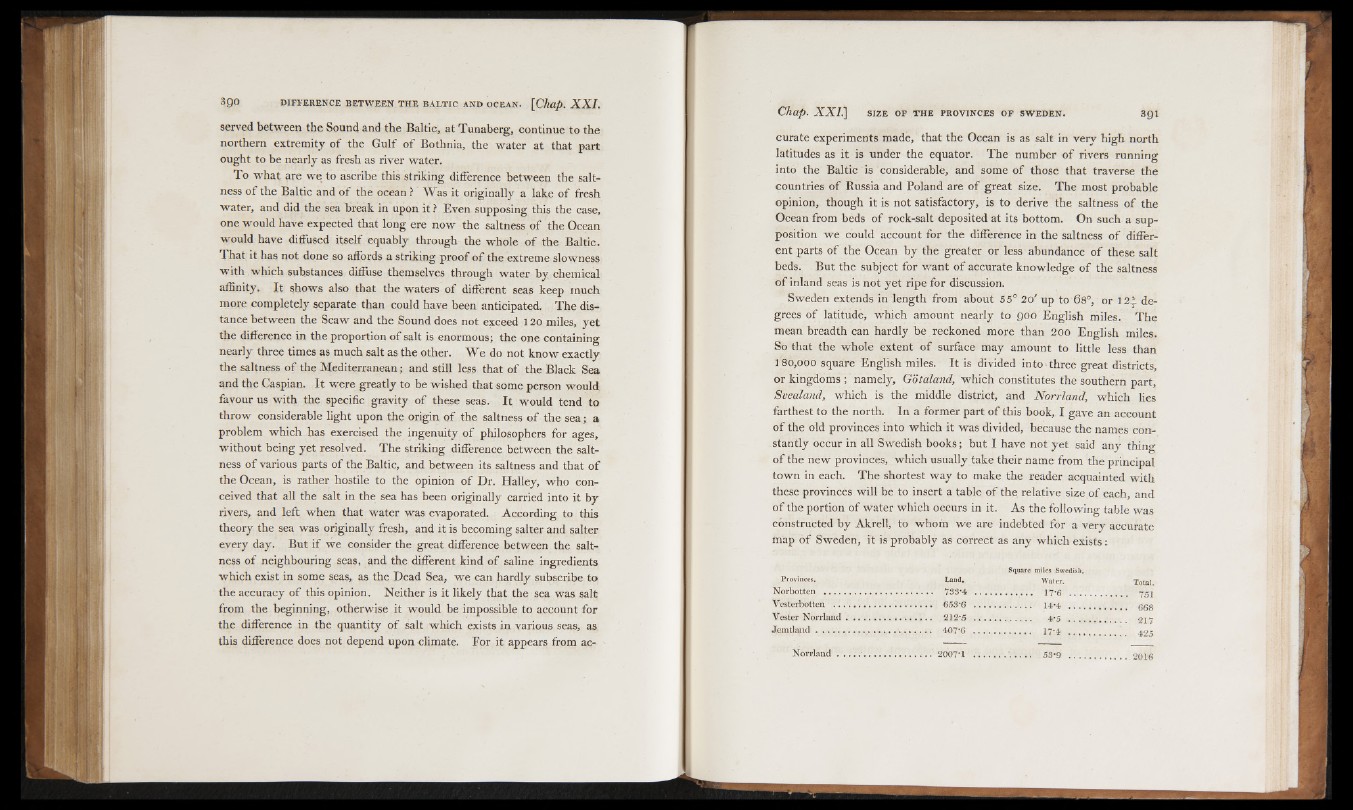
served between the Sound and the Baltic, at Tunaberg, continue to the
northern extremity o f the Gulf of Bothnia, the water at that part
ought to be nearly as fresh as river water.
To what are we to ascribe this striking difference between the saltness
of the Baltic and o f the ocean ? Was it originally a lake o f fresh
water, and did the sea break in upon it ? Even supposing this the case,
one would have expected that long ere now the saltness of the Ocean
would have diffused itself equably through the whole of the Baltic.
That it has not done so affords a striking proof of the extreme slowness
with which substances diffuse themselves through water by chemical
affinity. It shows also that the waters of different seas keep much
more completely separate than could have been anticipated. The distance
between the Scaw and the Sound does not exceed 120 miles, yet
the difference in the proportion of salt is enormous; the one containing
nearly three times as much salt as the other. We do not know exactly
the saltness of the Mediterranean; and still less that o f the Black Sea
and the Caspian. It were greatly to be wished that some person would
favour us with the specific gravity of these seas. It. would tend to
throw considerable light upon the origin of the saltness o f the sea; a
problem which has exercised the ingenuity o f philosophers for ages,
without being yet resolved. The striking difference between the saltness
of various parts of the Baltic, and between its saltness and that of
the Ocean, is rather hostile to the opinion o f Dr. Hailey, who conceived
that all the salt in the sea has been originally carried into it by
rivers, and left when that water was evaporated. According to this
theory the sea was originally fresh, and it is becoming salter and salter
every day. But if we consider the great difference between the saltness
of neighbouring seas, and the different kind of saline ingredients
which exist in some seas, as the Dead Sea, we can hardly subscribe to
the accuracy of this opinion. Neither is it likely that the sea was salt
from the beginning, otherwise it would be impossible to account for
the difference in the quantity of salt which exists in various seas, as
this difference does not depend upon climate. For it appears from accurate
experiments made, that the Ocean is as salt in very high north
latitudes as it is under the equator. The number o f rivers running
into the Baltic is considerable, and some o f those that traverse the
countries o f Russia and Poland are of great size. The most probable
opinion, though it is not satisfactory, is to derive the saltness o f the
Ocean from beds of rock-salt deposited at its bottom. On such a supposition
we could account for the difference in the saltness o f different
parts of the Ocean by the greater or less abundance o f these salt
beds. But the subject for want o f accurate knowledge o f the saltness
o f inland seas is not yet ripe for discussion.
Sweden extends in length from about 55° 20' up to 68°, or 12^ degrees
o f latitude, which amount nearly to 900 English miles. The
mean breadth can hardly be reckoned more than 200 English miles.
So that the whole extent o f surface may amount to little less than
180,000 square English miles. It is divided into three great districts,
or kingdoms ; namely, Gotaland, which constitutes the southern part,
Svealand, which is the middle district, and Norrland, which lies
farthest to the north. In a former part o f this book, I gave an account
of the old provinces into which it was divided, because the names constantly
occur in all Swedish books; but I have not yet said any thing
of the new provinces, which usually take their name from the principal
town in each. The shortest way to make the reader acquainted with
these provinces will be to insert a table o f the relative size o f each, and
o f the portion of water which occurs in it. As the following table was
constructed by Akrell, to whom we are indebted for a very accurate
map of Sweden, it is probably as correct as any which exists:
Square miles Swedish.
Provinces. Land. Water. T o tal.
Norbotten ...................
Vesterbotten .......... ..
Vester Norrland .......... 212*5 4*5 . . . . . . . . . . . . 217
Norrland . . . . . . . . . .................. 2007*1 ........... . . . . . . 53*9 ..........